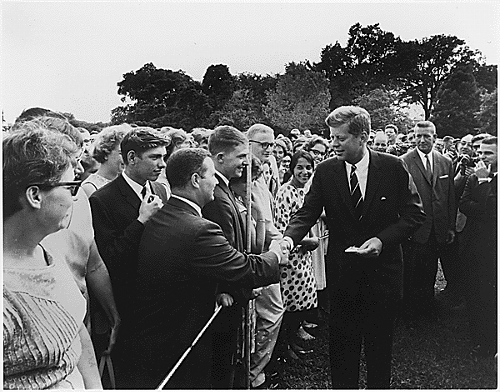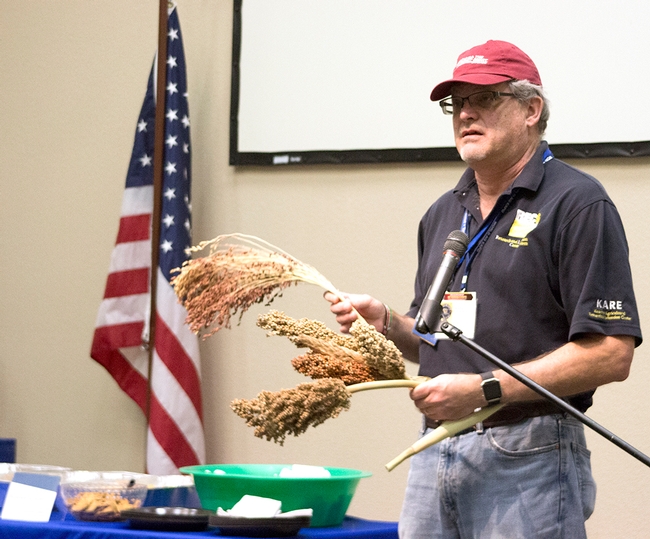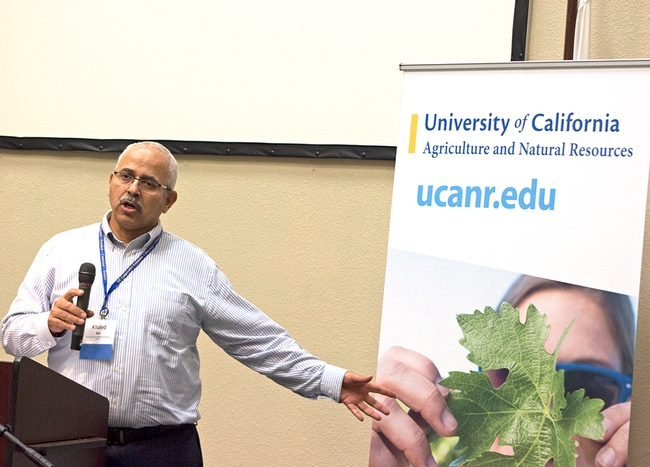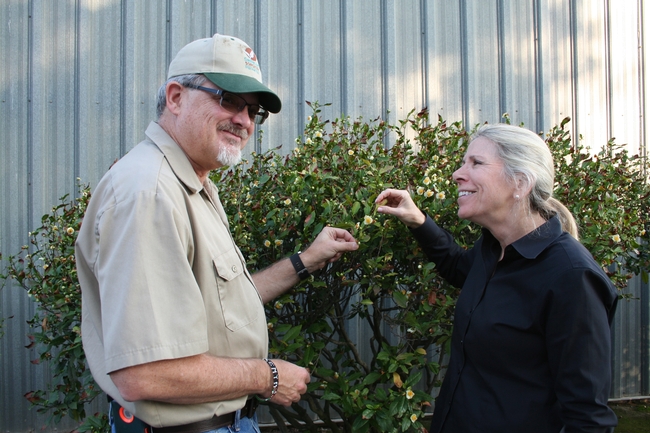Posts Tagged: Jeff Dahlberg
The drought may be over, but water concerns haven't been doused
Record winter rainfall during the 2016-17 winter has enabled farms to emerge from survival mode in the short term, but scientists are still working hard to be ready for the next drought, reported Tim Hearden in Capital Press.
Hearden spent a day at the UC Kearney Agricultural Research and Extension Center in Parlier to learn how researchers at the facility and the UC West Side Research and Extension Center near Five Points are combining technology with management practices to put every drop of irrigation water to work.
“This is one of the few places in the world where you can do drought research on a field level,” said Jeff Dahlberg, director of the 330-acre Kearney facility. “What I'm planning is a world-class drought nursery.”
At the West Side REC, researchers are working with farmers to perfect micro-irrigation efficiency and test drought stress on the area's most prevalent crops.
“We'll grow a tremendous number of cultivars of a crop” and identify “what seem to be the most promising cultivars when you grow them under drought conditions,” said Bob Hutmacher, a cotton specialist and the center's director.
Hearden spoke to Jeff Mitchell, UCCE cropping systems specialist and director of the Conservation Agriculture Systems Innovation center (CASI). CASI is encouraging farmers to adopt farming practices that save water, reduce dust and help improve the condition of soil, such as subsurface drip irrigation, overhead irrigation, minimum tillage, cover crops and crop residues.
“This is not done right now in California,” Mitchell said. “In the future, there may be a strong likelihood of certain agricultural sectors adopting these practices.”
Other subsurface irrigation trials are showing dramatic increases in yields. Khaled Bali, an irrigation water management specialist at Kearney, said underground drip systems in alfalfa fields have achieved 20 to 30 percent more yields while in some cases using 20 percent less water.
Kevin Day, a UCCE pomology advisor in Tulare County, is trying subsurface drip in a peach and nectarine orchard after working with the USDA to use it for pomegranates. He's seen as much as a 90 percent reduction in weeds because there's no surface water to feed them.
“Fewer weeds, fewer pesticides,” he said. “We use high-frequency irrigation. We irrigate as the crop needs it. When you do that, you keep the roots deeper, which makes for better aeration.”
Historical tea research may spark new industry in the San Joaquin Valley
Tea that was planted 50 years ago at the UC Kearney Agricultural Research and Extension Center may revive interest in growing the popular beverage in the San Joaquin Valley, reported Dale Yurong on ABC30 Action News. The reporter visited the 330-acre ag research facility Jan. 2 to get a first-hand look at what center director Jeff Dahlberg calls a "beautiful hedge."
In fact, the 13 landscape shrubs represent the best tea cultivars grown at Kearney when Lipton Tea was funding research to determine whether the Valley soils and climate could support production of plants to be used to manufacture instant tea. Today, a new trend is clearly brewing, Yurong said.
"Folks can't get enough tea," he said.
A researcher at UC Davis, who learned of the tea plants from documents stored by the campus' new Global Tea Initiative, was surprised to learn that the 50-year-old tea plants have survived and thrived. UC Davis chemistry professor Jacquelyn Gervay-Hague plans to study the soil where tea is growing to learn about the impact microbes in the rootzone may have on the health attributes of brewed tea.
Dahlberg has looped in the small-scale farm advisor for UC Cooperative Extension in Fresno County, Ruth Dahlquist-Willard, to research tea production at Kearney.
"I think (tea) does have potential for some high-value tea products," he said. "And I can really envision some small farmers getting involved in this."
Read more about the tea at Kearney here.
'Great Day' morning program features UC Kearney Ag REC
The popular morning television program "Great Day," which airs daily on KMPH Channel 26 in Fresno, featured the work of scientists at the UC Kearney Agricultural Research and Extension Center in six live segments during the five-hour program this morning.
Reporter Clayton Clark and photographer Ryan Hudgins arrived at the Kearney greenhouse at 4:30 a.m. to interview the scientists helping California farmers feed the nation and world sustainably.
See clips of the interviews in the one-minute video below:
Segments included:
- An overview of research and extension activities at Kearney by director Jeff Dahlberg.
- UC blueberry and blackberry research that has made these commodities important crops in the San Joaquin Valley with Manuel Jimenez, UC Cooperative Extension farm advisor in Tulare County.
- Beneficial insects, pests and invasive species that are part of research by Kent Daane, UCCE specialist in the Department of Environmental Science and Policy Management at UC Berkeley. Daane shared a handful of leaf-footed bugs with the reporter.
- How global information systems are changing the way farmers and researchers are looking at farmings systems with Kris Lynn-Patterson, coordinator of the GIS program at Kearney.
- Just like people, plants get sick. UC plant pathologist Themis Michailides explained research efforts to cure plant diseases.
- Uncommon wine varieties that might lead to new fine wines ideally suited to be produced in the Valley's warm climate, with Matt Fidelibus, UCCE specialist in the Department of Viticulture and Enology at UC Davis.
- The very real threat of West Nile virus in mosquitoes in the valley, with medical entomologist Anton Cornel.
Kearney research featured in World Ag Expo magazine
The official magazine of the World Ag Expo 2013 contains a three-page spread about sorghum research being conducted at the UC Kearney Agricultural Research and Extension Center by Jeff Dahlberg, director of the center.
Copies of the magazine will be available to visitors at the world's largest agricultural exposition Feb. 12-14 in Tulare. A pdf of the sorghum article is attached below.
In the article, Dahlberg says that, in the past, sorghum forages were not as good as corn for silage feed. But times have changed.
"We've come a long way from what your father or grandfather grew as sorghums years ago," Dahlberg said. "It's to the point now that we can compete with corn silage on both quality and tonnage."
In addition, Dahlberg said, sorghum uses from a third to half the water of corn silage, needs less nitrogen to produce the same yield, and has greater salt tolerance.
Carol Frate, UC Cooperative Extension advisor in Tulare County, told reporter Chris Bennett she is unsure of the precise role of sorghum for farmers.
"I'm looking at input costs and comparing them to yield potential and quality for milking cows," Frate said. "I would be a bit leery of the forage sorghums that grow so tall because of lodging issues. We've had some growers experimenting with them and then having 20 or 40 acres of sorghum that is pretty flat."
Sorghum is widely used in the western Panhandle of Texas, where dairies are turning to sorghum because of water issues.
"They're not losing very much by switching over and they have been pretty happy with forage sorghums," Dahlberg said.
Many UC academics heeded Kennedy's call to 'serve the cause of peace'
When President John F. Kennedy created the Peace Corps in 1961, he not only sent thousands of Americans to serve the cause of peace in the developing world, he set them on a course of service that continued when they returned to the U.S. A significant number came to work for UC Cooperative Extension.
One of them is Jim Grieshop, a now-retired UCCE community education development specialist, who was profiled in an article in the February issue of Alaska Airlines Magazine marking the Peace Corps' 50th anniversary.
Acceptance into the Peace Corps helped Grieshop achieve his personal goal of living and working in Latin America, the article said. In May 1964, he arrived in Cayambe, Ecuador, to spend two years as a science teacher. He quickly learned to be flexible.
"The science teacher in the village didn't really want me to teach science," Grieshop was quoted in the story. "So I taught English in primary schools and the high school . . . . We put on a rodeo, we did some summer programs - I was kind of making it up as I went along."
Here are some of the other UCCE academics, past and present, who served in the Peace Corps:
Monica Cooper, viticulture farm advisor in Napa County, volunteered in an agrarian community in Panama.
Jeff Dahlberg, director of the UC Kearney Agriculture Research and Extension Center, served for three years in the Republic of Niger.
Chris Dewees, retired specialist in Cooperative Extension marine fisheries, volunteered in Chile.
Morgan Doran, livestock and natural resources farm advisor in Solano County, volunteered in Ecuador.
Ben Faber, Ventura County farm advisor, served in Togo, Africa.
Mark Gaskell, small farm advisor in San Luis Obispo County, served in Venezuela.
Juan Guerrero, retired farm advisor emeritus for Riverside and Imperial counties, worked with subsistence farmers and large-scale commercial farmers in Paraguay and Peru.
Glenda Humiston, vice president, UC Agriculture and Natural Resources, served in Tunisia, North Africa.
Susan Laughlin, retired regional director, spent three years in Colombia.
David Lewis, watershed management advisor in Marin County, volunteered in Niger.
Mike Marzolla, retired 4-H advisor in Ventura County, coordinated a school and community garden program in Guatemala.
Richard Molinar, retired small-scale farm advisor for Fresno County, served in Honduras.
Jeff Mitchell, cropping systems specialist, UC Kearney Agricultural Research and Extension Center, served in Botswana, Africa.
Rachel Surls, UCCE sustainable food systems advisor in Los Angeles County, served in Honduras.
Jack Williams, the retired Sutter/Yuba county director, worked alongside farmers in Kenya, Africa.
Ken Wilmarth, former 4-H advisor in Stanislaus County, and his wife, Jenny, spent two years in Chavin, Peru.
Have I missed any UCCE Peace Corps volunteers? Please post a comment letting me know.

President Kennedy greets Peace Corps volunteers in 1961. (Photo: Wikimedia Commons.)





